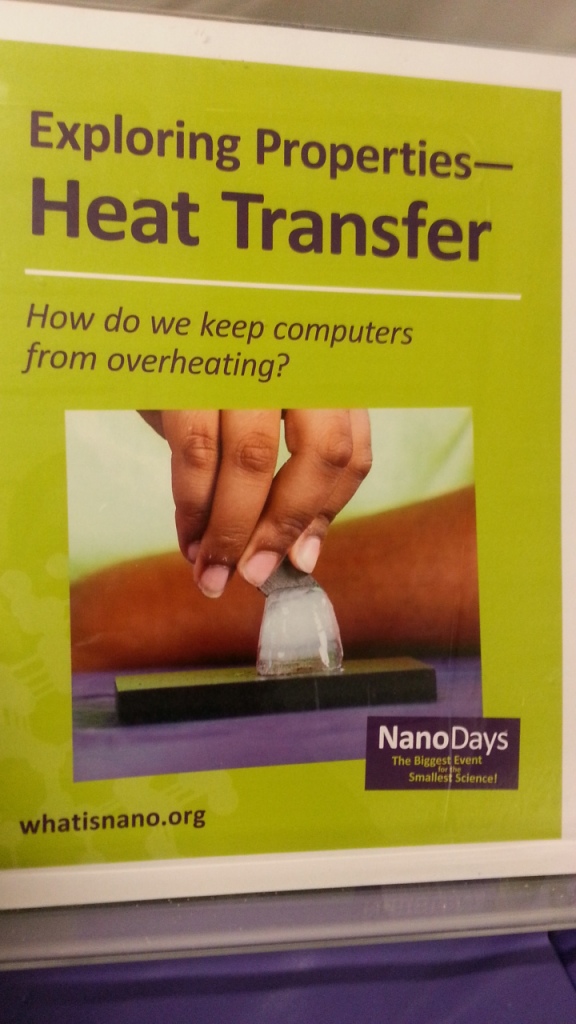By Khalid Straker, 4/16/15
During Spring Break the New York Hall of Science swarmed with visitors who took turns stopping in their tracks wondering what the two explainers behind the table were up to, sometimes even forming lines.
The New York Hall of Science were one of the many museums that took part in the annual Nano Days event. Nano Days is a nationwide festival of educational programs about nanoscale science and engineering and its potential impact on the future crated by the Nanoscale Inform Science Education Network. The first week of events that went nationwide was in 2008 with over 100 institutes participating. Now in 2015 over 250 institutes participated and one of those is the New York Hall of Science in Corona, Queens. Nano Days is made with people of all ages in mind and tries to engage them in learning about the growing field of science, which holds the promise of developing revolutionary materials and technologies.
The Hall of Science employs Explainers for the purpose of facilitating the museum experience and helping visitors understand exactly what they are seeing. Throughout Nano days there were two explainers at the exhibit at all times. In an interview, Hall of Science Explainer Shanna Ramsamooj spoke about how much she enjoyed the event. “I was looking forward to it since we were told it was going to happen.” She said “We got to use these tools that the [Nanoscale Inform Science Education Network] sent us and they helped us explain Nano-Technology and what it can do for us in the future. It was really cool to see visitors react to the exhibits and be really interested in the science behind them. It’s a shame it only lasted a week though.” The materials she mentioned include sand coated in the polymer polydimethylsiloxane which turns it into kinetic sand and sand coated in silicon which turns it into “Magic Sand” which is basically hydrophobic sand that doesn’t let water go through it as if it were a table made of marble. There were also aluminum blocks and pieces of graphite that showed off exactly what thermal conductors can do by quickly melting blocks of ice in comparison to a block of foam.

A piece of graphite quickly cuts through an ice cube to demonstrate thermal conductivity. Photo by Khalid Straker
“The goal here is to make the visitors aware of what Nano is,” said Explainer William Davalos in an interview. “We want them to know that it’s referring to a measurement that it one billionth of a meter small. That means we’re talking about things that are so little, you can’t even see this stuff on a microscope. We also want them to see how those billions of happenings on the Nano scale affect what happens and what we see with our own eyes on the macro scale. So there’s so many little tiny things going on that it becomes a big thing and that’s what we want people to learn.”
Another driving point of the event is to encourage visitors to think of how these things can be used. The hydrophobic sand coated in silicon was actually created to clean up oil spills in the ocean. The sand can coat the oil in the water and bind to it while never mixing with the water so it can actually serve as an isolation balloon for the oil. The oil will eventually clump together and sink to the bottom of the ocean. This method isn’t done anymore as it is very expensive and scientists aren’t sure about how environmentally safe it is. However silicon is still used on other objects because its resistance to water is very useful. There are a lot of electric wires and even pants that use silicon to avoid getting wet. Aluminum and graphite are also used for their ability to quickly conduct heat. There is actually graphite in laptops that take the heat generated and pass it from the processor to the fan where the hot air can be blown out to keep the computer cool. Foam is a poor thermal conductor so it actually keeps heat where it is. That is why there are many jackets laced in foam so keep the heat on the wearer. Foam is even used in food containers for the same purpose. Many visitors actually figured out these uses on their own and some came to much more colorful conclusions like using polydimethylsiloxane, a polymer that helps objects stick to one another, to climb walls like Spider-Man.
Needless to say, Nano Days 2015 was a success in the New York Hall of Science and the staff is looking forward to Nano Days 2016.